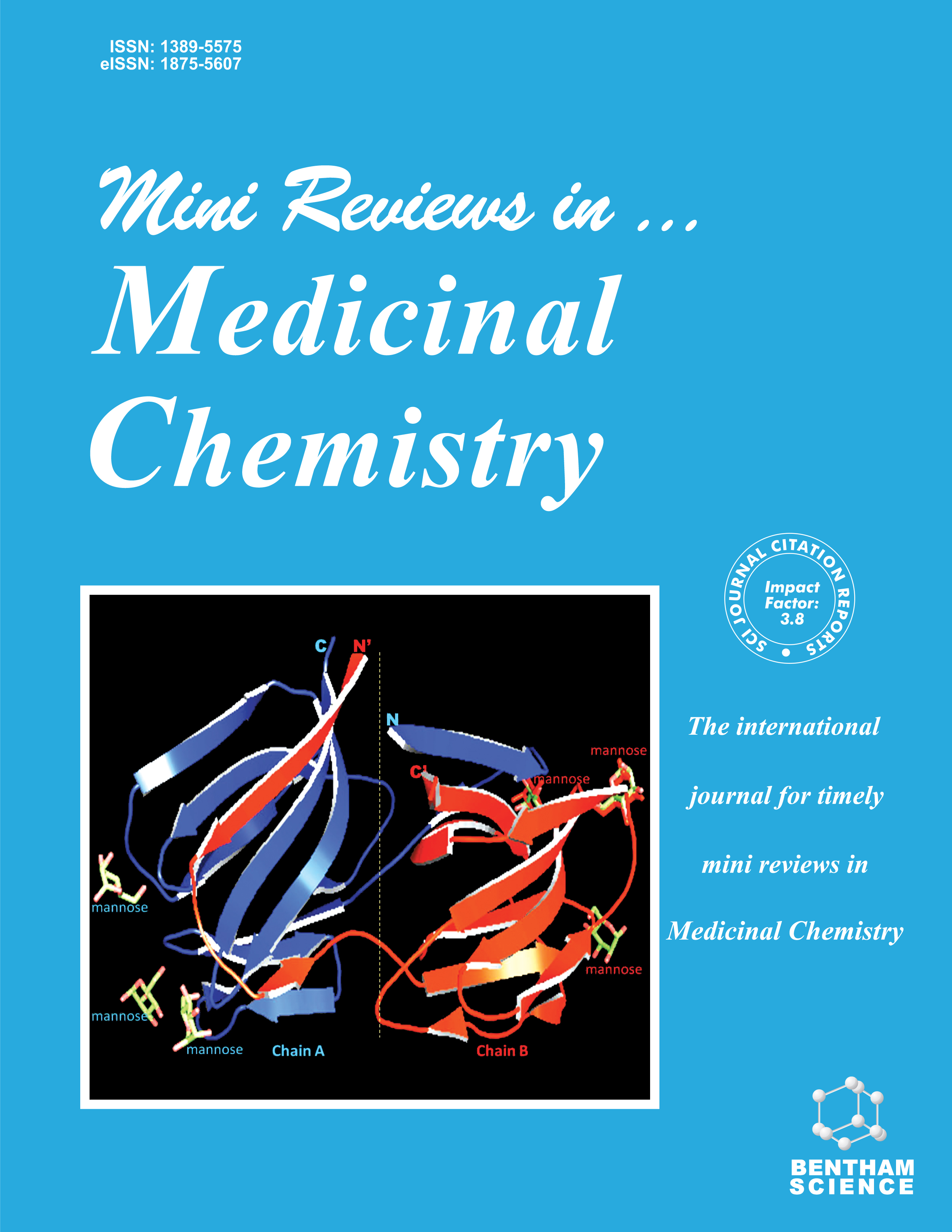- Home
- A-Z Publications
- Mini Reviews in Medicinal Chemistry
- Previous Issues
- Volume 6, Issue 7, 2006
Mini Reviews in Medicinal Chemistry - Volume 6, Issue 7, 2006
Volume 6, Issue 7, 2006
-
-
Structural and Functional Properties of NAD Kinase, a Key Enzyme in NADP Biosynthesis
More LessAuthors: Giulio Magni, Giuseppe Orsomando and Nadia RaffaelliNAD kinase is an essential enzyme, which plays a key role in cellular energy and signal transduction systems. Inthis report, the recent studies on the features of bacterial and human NAD kinases are summarized. They include detailedkinetic and structural analyses and highlight important differences, which could be exploited for the design of novelselective antimicrobial drugs.
-
-
-
Fused 1,4-Dihydropyridines as Potential Calcium Modulatory Compounds
More LessAuthors: Cihat Safak and Rahime Simsek1,4-Dihydropyridine (1,4-DHP) derivatives nifedipine of which the prototype, are the most popular drugs having calcium antagonistic activity. Fused 1,4-dihydropyridines (DHPs) have also exhibit calcium modulatory activities. In this article, weemphasizecalcium channels and fused 1,4-DHP derivatives affecting calcium channels. In addition, the basic considerations of synthesis, metabolism, structure-activity relationships and Read More
-
-
-
Function and Molecular Mechanism of Tumor-Targeted Peptides for Delivering Therapeutic Genes and Chemical Drugs
More LessAuthors: Ryan Craig and Shulin LiTumor-targeted chemo- or gene-therapies is a new form of treatment which provides the benefits ofreducing systemic toxicity, increasing the tolerance, and enhancing therapeutic efficacy. This review willdiscuss the discovery, function, application, and mechanism by which the short peptides (5-9) work for tumor-targeted gene or drug delivery.
-
-
-
Myostatin: Biology and Clinical Relevance
More LessAuthors: Gilles Carnac, Stephanie Ricaud, Barbara Vernus and Anne BonnieuMyostatin is a negative regulator of muscle mass. Important advances in our understanding of thecomplex biology of this factor have revealed the therapeutic potential of antagonizing the myostatin pathway. Herewe present the rationale for evaluating anti-myostatin therapies in human muscle-wasting disorders.
-
-
-
Biological Therapies For Inflammatory Bowel Disease: Research DrivesClinics
More LessAuthors: Silvio Danese, Stefano Semeraro, Alessandro Armuzzi, Alfredo Papa and Antonio GasbarriniThe better understanding of the mechanisms of inflammatory bowel disease has driven our progress intothe development of new biological therapies targeting specific molecules. Anti-TNFα biologic compounds have shown great efficacy particularly in Crohn's disease. Infliximab (an IgG1 mouse/human chimeric monoclonal anti-TNFα antibody fragment) is the most efficacious compound in inductionand maintenance thera Read More
-
-
-
New Inotropic Pharmacologic Strategies Targeting the Failing Myocardiumin the Newborn and Infant
More LessAuthors: Alex Veldman, Stefan Rupp and Dietmar SchranzPharmacologic support of the failing neonatal heart to maintain cardiac output, which is vital for sufficient end organ perfusion, is a challenging task for the pediatric intensivist, especially since strategies which have been proven to be effective in adults cannot necessarily be extrapolated to neonates. The unique biochemical properties and structure of the neonatal heart, including the increased non-contractile tissue mass, a Read More
-
-
-
Synthesis and in vitro Modeling and Characterization of Self-AssemblingDrug Conjugates for Targeted Medicinal Application
More LessBy D. K. SarkerA number of conjugates tend to self-associate in a transient or permanent fashion and this has formed the basisof considerable intense scientific and commercial investigation over recent years. This article considers a variety ofstrategic formulations, their flaws and advantages. Working practices and groundbreaking developmental activities withinthe sphere of self-assembling drug conjugates are also reviewed.
-
-
-
Structural Properties of the NMDA Receptor and the Design of Neuroprotective Therapies
More LessAuthors: A. M. Gerber and M. L. VallanoNMDA receptors are linked to neuronal loss in stroke and neurodegeneration because their activation can triggerexcitotoxic Ca2+ dysregulation. Accordingly, NMDA receptor antagonists are neuroprotective, providing a rationale fortheir clinical application. However, side effects often outweigh benefits. Herein we highlight structural properties inreceptors that are used in drug development.
-
-
-
Chemical Communication-Do We Have a Quorum?
More LessAuthors: Monika I. Konaklieva and Balbina J. PlotkinThere are two types of bacterial communication systems, those in which the signal produced by bacteria isdirected only at other organisms, and those where the signal is detected by others and self. The latter is involved inadaptation to the environment. The adaptation signals are autoinducers, the response is population density-dependent andhas been termed "quorum sensing". Our current knowledge of bacterial Read More
-
-
-
Cyclooxygenases in Cancer: Chemoprevention and Sensitization to Conventional Therapies
More LessAuthors: Y. T. Jeon and Y. S. SongWe have focused on cyclooxygenase, the key enzyme in prostaglandin synthesis, from our basic knowledge regarding the enzyme, to its clinical application in the field of oncology. We will present evidence that this enzyme is intimately associated with carcinogenesis, invasion, metastasis, and the response of tumors to current therapeutic modalities in a variety of human malignancies. We will also discuss the applications of cyc Read More
-
-
-
Angiotensin II Receptor Blocker: Possibility of Antitumor Agent for Prostate Cancer
More LessAuthors: Hiroji Uemura, Hitoshi Ishiguro and Yoshinobu KubotaIt is known that the renin-angiotensin system (RAS) plays a fundamental role not only as a vasoconstrictor incontrolling blood pressure and electrolyte/fluid homeostasis, but also as a mitogenic factor through the Ang-II type-1(AT1) receptor in smooth muscle cells and cardiac myocytes. Angiotensin II (Ang-II) is indeed thought to be a growthfactor, and Ang-II receptor blockers (ARBs), a class of antihypertensive agent, sup Read More
-
Volumes & issues
-
Volume 25 (2025)
-
Volume 24 (2024)
-
Volume 23 (2023)
-
Volume 22 (2022)
-
Volume 21 (2021)
-
Volume 20 (2020)
-
Volume 19 (2019)
-
Volume 18 (2018)
-
Volume 17 (2017)
-
Volume 16 (2016)
-
Volume 15 (2015)
-
Volume 14 (2014)
-
Volume 13 (2013)
-
Volume 12 (2012)
-
Volume 11 (2011)
-
Volume 10 (2010)
-
Volume 9 (2009)
-
Volume 8 (2008)
-
Volume 7 (2007)
-
Volume 6 (2006)
-
Volume 5 (2005)
-
Volume 4 (2004)
-
Volume 3 (2003)
-
Volume 2 (2002)
-
Volume 1 (2001)
Most Read This Month
Article
content/journals/mrmc
Journal
10
5
false
en


